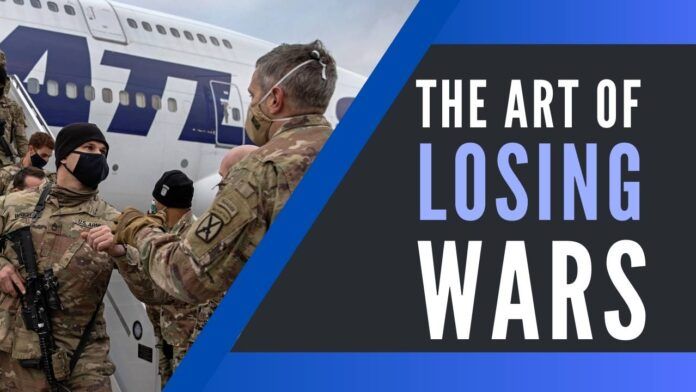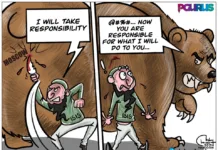
US war history and exit strategies
After being in the war for almost 20 years, if a powerful army exits the battlefield in the pitch dark of the night, switching off power and lights and without informing the host nation, the only word that describes it is ‘Defeat’. This is precisely what the US forces did when they vacated Bagram Airbase, north of Kabul on the night of 2nd July 2021[1], fearing an attack on their departing personnel, from the Taliban, or even from elements in the Afghanistan army opposed to the US. For a super-power that spent over USD 2.2 trillion in 20 years, this kind of exit is nothing short of capitulation[2].
An uncannily predictable pattern can be drawn up from all the major wars fought by the USA after World War II– Go in with a bang – Go out with a whimper. It starts all major wars based on non-existent or misjudged causes. Its technology and military superiority enables it to start a war anywhere in the world and gain initial military success with ease. But when it comes to sustaining and consolidating these wins, it has a predictable pattern of losing the plot and leaving a huge pile of mess in the invaded nation, and an additional headache to the whole world.
With every American loss, the world is that much more unsafe and the USA slips a few steps down from its superpower status.
The biggest war fought by the USA after World War II was its war in Vietnam between 1964-1975. The ostensible purpose of this war was to stop and contain the expansion of Communist forces. It had a huge superiority over PAVN (People’s Army of Vietnam) that enabled it to make big gains in the initial phases. It could stop the advance of the communist North-Vietnam into the democratic South-Vietnam. However, it completely failed to consolidate its gains and defeat a technologically and numerically weak enemy. As the Viet-Cong and PAVN fighters started inflicting casualties on the US forces, they retaliated with excessively brute force causing huge casualties and severe inhuman wounds when they used chemical weapons like Napalm bombs.
The estimated Vietnamese civilian deaths during this war far outnumbered the military deaths at approximately 2 million. The US took its largest number of casualties in its history of 58,000 dead, 303,000 wounded, and 1600+ MIA (Missing In Action). Between 29th-30th April 1975, the US evacuated its citizens and many Vietnamese citizens were considered ‘at at risk’ in the world’s largest evacuation by air, especially by helicopters. When the last chopper took off from the US embassy roof-top at 7.53 am on 30th April 1975 carrying Major Kean and the 10 remaining marine security guards, they could see a swarm of civilians invading and occupying the embassy building below them. By 11.30 am the same day, the flag of Viet-Cong was hoisted at the Presidential palace in Saigon, less than 1km from the US embassy ending a war that left behind a mess in Vietnam and deep scars in several East-Asian countries including Cambodia, Laos, and the entire Indo-China region.
When President George Bush Junior invaded Iraq in the year 2003, his justification was a non-existent threat of Weapons of Mass Destruction (WMD) by Saddam Hussein[3]. With severe sanctions and embargoes on Iraq, the US Intelligence was fully aware of the audit trail of chemicals available with Iraq, which conclusively showed that Iraq couldn’t produce WMD. Yet, this false alibi was trumped up by the US Govt and echoed by its media and think tanks. Once the justification was made, the rest of the war machinery delivered initial success in no time. In a few weeks and months, the Iraqi army was made ineffective, most of its war assets were taken out and Saddam Hussein, the then President of Iraq, was arrested. While Saddam Hussein was no saint, he was definitely more tolerant and liberal compared to most other despots in the Middle East. People of non-Islamic faith had the freedom to follow their religions, and there was no Islamic extremism or terrorism. Women could wear clothing of their choice and partying and liquor were not termed as Haram. He was the only leader from the Middle East who had officially recognized Bharat’s complete sovereignty over the state of Jammu & Kashmir and supported it in all the resolutions moved against it at the OIC (Organization of Islamic Countries) on the Kashmir issue.
After Saddam Hussein was captured, the US lost interest in Iraq and allowed it to slide into chaos, anarchy, and religious fundamentalism[4]. While the Americans never found WMD, they helped in creating different types of WMDs, the most dangerous of which, was the Islamic State of Iraq and Syria (ISIS). America’s invasion of Iraq created a massive humanitarian crisis with more than 4.4 million internally displaced, out of which almost half of them left the country and most entered Europe, becoming a demographic WMD there. Thousands of Iraqi women who otherwise led respectable lives were forced into prostitution to support their families. Iraq sadly became a sex-tourism destination in the region. With a sharp decline of HDI indicators in Iraq, like malnutrition at 30%, Iraq has seen an exodus of more than 50% of its doctors and medical personnel, further hurting the recovery of HDI. While the US had approximately 5000 casualties and 35000 wounded, overall, along with its allies, the invasion resulted in more than 25000 deaths to the invading armies and cost US tax-payer USD 1.7 trillion. When the USA left Iraq in 2011, it left a completely devastated country torn by sectarian and ethnic conflicts. The world watched in horror the swift and brutal rise of ISIS, its killing fields, its markets selling Yezdi and Christian girls, and its impactful appeal to thousands of willing volunteers from across the globe, more significantly from Europe to their brutal cause. Since then, the world saw several terrorist attacks including lone-wolf attacks.
No major city in the world, especially in the West is safe any longer. The traditional Jehadi terrorism machinery had specific organizations, funding sources, and supporting structures before ISIS was born. Post the birth of ISIS, Jihadi terrorism is no more dependent on an organization for sustenance, and therefore, extremely difficult to trace and neutralize. The Iraq invasion has resulted in a dangerous existential and untraceable threat.
When the Afghan national army discovered several hours later on the 3rd July 2021 morning that the Americans had abandoned the Bagram airbase in the night without informing them, they also found more than 5000 radicalized Taliban fighters locked up in the prison cells at the base[5]. The retreating Americans didn’t even hand over the keys to these prisons to the Afghan troops. Had the Taliban prisoners broken free before the Afghan army found them, Bagram airbase would have fallen to the Taliban. As the last flight evacuated from Bagram at 3 am on 2nd July 2021, the US has left the nation of Afghanistan on the brink of retreating to the intolerant and violent religious extremism of medieval ages. The US is leaving Afghanistan more dangerous to the world now than it was in 2001 when they invaded it. President Joe Biden recently announced that they had achieved their objectives in Afghanistan. If their target was Osama Bin Laden and Al-Qaeda, how does the US justify staying there for a decade more after Laden was killed? If they aimed to deny safe-haven for Jihadi organizations, Afghanistan already has several extreme Jihadi organizations besides Taliban and Al-Qaeda, like ISIS. Once the Taliban takes control of Kabul, what can prevent all the Jihadi outfits from making Afghanistan their haven?
The US wanted to stop communists in Vietnam – Vietnam is still communist today. The US wanted to destroy the WMD in Iraq – and ended up creating more WMDs like the ISIS and demographic attacks on Europe. The US wanted to remove the threat of Jihadi terrorism from the soil of Afghanistan – and Afghanistan is falling back to a worse position than where it was before the American invasion[5]. The US wanted to control the Horn of Africa and deny safe-havens to the Somali pirates hijacking several western cargo ships – today Somalian pirates are still a threat in those waters. American involvement even in Libya, Somalia, Syria, Uganda, or elsewhere, the pattern has been predictably the same. Firstly, create an alibi of threat or wrong-doing; secondly, whip up public opinion especially back home; thirdly, intervene into those countries almost always without UN mandate; fourthly, dump huge munitions causing untold miseries to the civilians, which is white-washed by their media and think-tanks as minor collateral damages; and finally, exit the country leaving it helpless and in tatters worse than it was before the invasion, and thus create several avoidable problems to the world.
With every American loss, the world is that much more unsafe and the USA slips a few steps down from its superpower status. While the US Govt declares success in some of these interventions, it has mastered the art of losing all major wars that it foolishly or arrogantly initiates.
Note:
1. Text in Blue points to additional data on the topic.
2. The views expressed here are those of the author and do not necessarily represent or reflect the views of PGurus.
References:
[1] U.S. military vacates the main airbase in Afghanistan but slows withdrawal plan – Jul 02, 2021, Washington Post
[2] What’s in the $2.2 trillion coronavirus Senate stimulus package – Mar 26, 2020, Washington Post
[3] Why did Bush go to war in Iraq? – Mar 20, 2019, Aljazeera
[4] Iraq Timeline: Since the 2003 War – May 29, 2020, USIP.org
[5] United States left Afghan airfield at night, didn’t tell new commander – Jul 06, 2021, ET
- Crumbling throne of the Dragon - November 4, 2023
- Saving the Hindus of Bangladesh - August 14, 2023
- Time for Bharat to take over from India - May 24, 2022











Every Empire comes to an end when the money runs out.
In this case when people realise that money is just printed paper which is printed at will and pleasure ( maybe these days digitally dispersed over the net), it will finally happen.